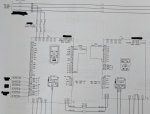I see the load side 20 hp drive is powered only on its DC bus and has no AC line side connection. The line side 50 hp drive has its own motor load connection plus the full load of the 20 hp drive connected on its DC bus.
I have seen some weird combinations but usually new retrofit drives that are taking a second source in on their DC bus. Usually it's noise mitigation and the second source has something weird, like an active front end, but the panel drive combo builder (apparently) did not want to go full hp with the AFE, so they go with a smaller unit feeding in on the DC bus of a more standard full hp rated unit for the load connection to the motor.
Seen some retrofits that will replace a 12 pulse drive with a six pulse drive, but reuse the existing phase shifting transformer and put another rectifier on that and refeed out to the new six pulse drive's DC bus.
I got the feeling the drive manufacturer would be none too happy about some of these retrofit combos.
If I had to guess I would say they need the 20 hp drive for the load connection to the motor, they need that to drive the actual load.
I have no guess as to why the 20 hp drive has no AC line side connection of its own. I'm sure it has a good front end.
I have no guess as to why they solved some apparent problem using the 50 hp drive's front end to feed the 20 hp drive on it's DC bus. Past combos I seen were spec'ed to reduce harmonic loading on the supply. But I do not see how that could apply here.
It looks like some off label creation of the panel builder so they would be the ones to ask first why they did it that way. I don't see how the drive manufacturer would recommend that connection.
I would kind of roll my eyes if it was because of a better front end on the 50 hp drive. Maybe something specific at the time of new installation that may or may not apply now with changes in new equipment and technology.


